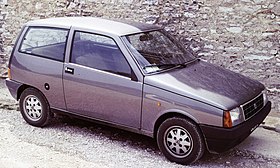| Autobianchi Y10 / Lancia Y10 | |
|---|---|
 Autobianchi Y10 | |
| Overview | |
| Manufacturer | Fiat Auto (1985–1986) Alfa-Lancia Industriale (1987–1991) Fiat Auto (1991–1995) |
| Also called | Lancia Y10 |
| Production | 1985–1995 |
| Assembly | Desio (MI), Lombardy, Italy (1985–1992) Alfa Romeo Arese (MI) Plant, Lombardy, Italy (1992–1995) Alfa Romeo Pomigliano d'Arco (NA) plant, Campania, Italy (1987–1995)[1] Mirafiori, Turin, Italy[2] |
| Designer | Antonio Piovano[3] and Tom Tjaarda[4] at Centro Stile Fiat |
| Body and chassis | |
| Class | Supermini (B) |
| Body style | 3-door hatchback |
| Layout | FF layout or 4WD |
| Related | Fiat Panda |
| Powertrain | |
| Engine | |
| Transmission | 5-speed manual CVT automatic |
| Dimensions | |
| Wheelbase | 2,159 mm (85.0 in) |
| Length | 3,390 mm (133 in) |
| Width | 1,510 mm (59 in) |
| Height | 1,420 mm (56 in) |
| Curb weight | 780 kg (1,720 lb) |
| Chronology | |
| Predecessor | Autobianchi A112 |
| Successor | Lancia Ypsilon |
The Autobianchi Y10 is a supermini and economy car manufactured from 1985 to 1995 and marketed under the Lancia brand in most export markets (as Lancia Y10). The car was manufactured at Fiat's Autobianchi plant in Desio, Milan until 1992 and after that in Arese, near Alfa Romeo's plants. In addition to a relatively high level of trim for its market segment, the Y10 featured a new rear rigid axle suspension design (called Omega axle), subsequently shared with the facelifted Fiat Panda. In spite of its short overall length, the Y10 had a drag coefficient of just 0.31.
Production totaled approximately 850,000 in the first seven years, in spite of being a pricier, more niche-oriented product than its Fiat siblings. In addition to unique style and luxurious trim, the Y10's aerodynamics increased the fuel economy. Sales in the United Kingdom were never strong, and it was withdrawn in late 1991. This was more than two years before Lancia withdrew entirely from Britain and all other RHD markets. Lancia remained in the segment in left-hand drive markets with the similarly marketed Ypsilon.
- ^ "Fiat di Pomigliano: riapre la fabbrica, ma a ottobre addio all'Alfa". metropolisweb.it (in Italian). Archived from the original on 22 April 2017. Retrieved 4 September 2011.
- ^ "Cassa integrazione per Fiat" (in Italian). Archiviostorico.corriere.it. Retrieved 21 January 2016.
- ^ "Y10 FIRE : le bouquet final d'Autobianchi". lautoscope.fr (in French). 4 April 2020. Retrieved 29 January 2024.
- ^ "Tom Tjaarda - Cars". tom-tjaarda.net. Retrieved 17 December 2019.